When it comes to popular music, each of the songs has some kind of chord progression. Of course, some are easier than others. Some chord progressions are so obscure and difficult that they are the hardest part of the song.
On the other hand, there are so many famous songs with the simplest possible chord progression where the focus is on lyrics or guitar solo.
If you are a beginner player there are few guitar progressions you must know if you expect to improve your playing skills. Furthermore, there are famous songs that have one chord during the whole length of the track.
With this in mind, you might understand how something like chord progression can go from being extremely simple to be extremely hard.
In addition, there are so many pop songs that use the same three or four chords, and yet they sound so different.
If you are new to guitar theory or music theory I suggest you read Guitar Music Theory In Depth Basics a lesson I wrote.
if you feel like your chord changing techniques are not quite there, check out my 17 Tips & 5 Exercises To Improve Your Guitar Chord Changing
What Is Chord Progression
But what is a chord progression, anyway? The chord progression is a sequence of two or more chords during the segment of the song. It can be intro, verse, chorus, or anything else. Any chords that are played one after the other will make a chord progression.
Similar to the scale, there are certain rules about building a progression, but more on that later. For now, it is only important to know that when you play three chords like C, G, and D, that is called a progression of chords.
Basically, the chord progression will be the foundation of your song, and you will base the rest of the song around it.
Of course, if you play with the band, you would consider other instruments as well. But for writing using only your guitar, progression will be the basis of your song.
How To Read Guitar Chord Progression
There are several ways how musicians could write something like the chord progression. Since before music could be recorded as easily as today, musicians needed a way to somehow write their songs. Of course, if you could read sheet music you will have no problems with chord progressions.
However, there are two other ways that you might encounter on your musical journey.
First Way
The first one is the one you probably encountered already. It is the simplest way of writing music. The idea is to have the lyrics of the song and simply write chords above the line where the chord is changed.
Each of these writings will have different segments where the first part would be the intro, for example. If there is an intro to the song, you would simply write the chord progression that is used for the intro. And after that, you would write chords above the lyrics whenever there is a chord change.
While it might be complicated seeing dozens of chords used for the single song, the truth is that there is a much simpler chord progression behind them. What you would need to do is to see how many unique chord changes there are during the song.
It might turn out that there are only three or four different chords for the entire song. We would use letters to address each chord where C would be C major, Cm is minor, Cm7 is C minor seventh, and so on.
Second Way
The second way of writing the chord progression is using the so-called Nashville number system. The main idea behind this system is to simplify the progression and use only numbers instead of letters.
This system is using Roman numerals to mark chord progression. Here, we have seven numbers where upper case numbers are used to mark major, while the lower case is used for minor chords.
The first number is the root, the second one is minor second, the third one is also minor, the fourth and fifth are major, the sixth is minor, and the seventh is diminished.
If you opt to use numbers instead of letters, you will have the freedom to play the song in any key you want without thinking too much about it.
For example vi – I – V – IV is a chord progression where the first chord is minor, and the other three are major. But we don’t know what key is the song in.
| Key | I | ii | iii | IV | V | vi | vii⁰ |
| C major | C | Dm | Em | F | G | Am | B⁰ |
| G major | G | Am | Bm | C | D | Em | F#⁰ |
| D major | D | Em | F#m | G | A | Bm | C#⁰ |
| A major | A | Bm | C#m | D | E | F#m | G#⁰ |
| E major | E | F#m | G#m | A | B | C#m | D#⁰ |
| B major | B | C#m | D#m | E | F# | G#m | A#⁰ |
| F# major | F# | G#m | A#m | B | C# | D#m | E#⁰ |
| F major | F | Gm | Am | Bb | C | Dm | E⁰ |
| Bb major | Bb | Cm | Dm | Eb | F | Gm | A⁰ |
| Eb major | Eb | Fm | Gm | Ab | Bb | Cm | D⁰ |
| Ab major | Ab | Bbm | Cm | Db | Eb | Fm | G⁰ |
| Db major | Db | Ebm | Fm | Gb | Ab | Bbm | C⁰ |
| Gb major | Gb | Abm | Bbm | Cb | Db | Ebm | F⁰ |
| Cb major | Cb | Dbm | Ebm | Fb | Gb | Abm | Bb⁰ |
By using this chart, and taking any song you want, you could simply write the numbers above each chord in the song, and figure out the progression behind them. After that, you can practice playing that song in any other key.
Of course, it is worth mentioning that this table above is for the Ionian or Major mode only.
Furthermore, there are seven modes in total and they are Lydian, Ionian, Mixolydian, Dorian, Aeolian (or natural minor), Phrygian, and Locrian. The first three modes are major, the second three are minor, and the last one is diminished.
if you are looking for your next gear or an accessory that can improve your playing experience but you are not sure what it is exactly, make sure to check my post Top 27 Must Have Guitar Accessories For Every Guitarist
9 Easy Common Guitar Progressions
I – IV – V
The first progression that you should learn is the I – IV – V. If we use this chord progression in C major, we will get one of the most popular progressions in modern music.

As we can see the I – IV – V progression became C F G in the C major key. Not only that this progression is rather simple, but there are so many songs that use this very chord progression.
For example, Twist and Shout by the Beatles use C F G chord combination, as well as La Bamba by Ritchie Valens. Both of these songs will use this same progression, but they still sound unlike each other.
I – I – I – I IV – IV – I – I V – V – I – I
The I – IV – V has another variation to it with a twelve-bar blues. Using this chord progression, the full 12 bars would be more like I I I I IV IV I I V V I I. Where the first four bars would be for the root.
If we translate the 12 bar blues to chords in, let’s say, E, we would get E – A – B. Finally, the full transcription of the 12 bar blues in E would be E E E E A A E E B B E E
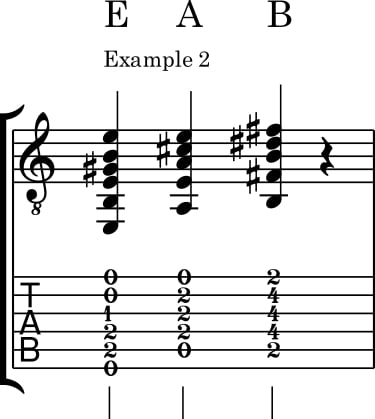
There are so many songs created on the 12 bar blues like Mustang Sally by Buddy Guy (originally by Wilson Pickett), Pride and Joy by Stevie Ray Vaughan, Have you ever loved a woman by Freddie King, and so on.
Something else you could do while playing I – IV – V combination of chords for twelve-bar blues, is to add sevenths. You could play with each chord replaced with seven so you’d get I7 – IV7 – V7. Finally, another option that you could play is to replace the first one with a minor, and the last one with 9th.
Another example of this progression is Walk of Life by Dire Straits where you could see the chords changing and what you can really do with the simple chord progression.
I – vi – IV – V
The third progression is similar to the previous ones, but with another chord. So this time, we will have four instead of three chords.
While this might sound more complicated, there will be even more songs with this combination than you can imagine.
So let’s take a look at the key of C one more time. Of course, you could always use the table above to try any other key you might like.
In the key of C, these four chords are C – Am – F – G. As you can see, we only have one new chord here or A minor. However, this allows us to create a whole new specter and feeling with only one new chord.
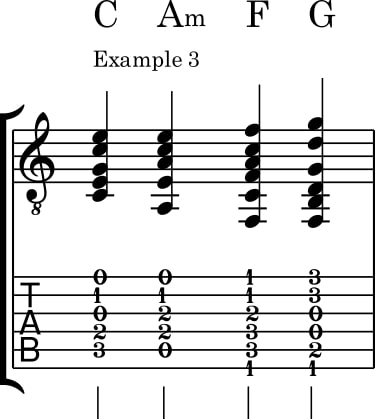
Not only that this is an extremely popular chord progression, but you also have countless songs using this exact progression. One of the most popular songs in this progression is Every Breath You Take by the Police.
vi – IV – I – V
By simply rearranging chords from the previous example, we get a combination that Toto used for Africa, Green Day in 21 Guns, The Misfits in Dig Up Her Bones, and Red Hot Chili Peppers in Don’t Forget Me.
As you can see, there is so much you can do with the same four chords.
I – vi – ii – V
Similar to the previous example, we will use four chords to create a new chord progression. This time we will have a second minor instead of the fourth major.
This progression is also known as the 50s progression or even doo-wop progression.
4 Progressions For Three Chord Song
When it comes to easy chord progressions, you could simply use three chords and create progression around them.
For example, taking the root, the fourth and the fifth will allow you to create many different progressions.
Here is an example:
I – I – IV – V
I – IV – V – V
I – IV – I – V
I – IV – V – IV
As you can see, we were able to create four different progressions using only three chords. Now, it’s up to you to decide which key you like the most, and experiment using these four-chord progressions.
7 Easy Rock Guitar Chord Progressions
When it comes to rock and roll, most progressions were inspired by blues songs and blues progressions.
Rock and roll would use the same 12 bar blues progression, with only different tempo and speed. While it might sound quite different, rock music would use the same progressions (more or less) as their predecessors.
I – vi – IV – V
one of the most popular progressions in rock music is I – vi – IV – V which would in C major sound like C – Am – F – G. As you can see, we already mentioned this chord progression before.
I – IV – V – I
This is another popular is the popular progression we encounter before, and it’s used in songs like It Ain’t Me Babe by Bob Dylan, which still falls in the three-chord category.
If you want to put those chord progressions to practice you can check out my list 25 Famous & Easy Acoustic Guitar Rock Songs For Beginners
I – V – vi – iii – IV – I – IV – V
This specific chord progression is used for Pachelbel’s Canon. If we translate this progression in D major we would get D – A – Bm – F#m – G – D – G – A.
While it might sound complex, you probably heard it on the radio in the song I Should Be So Lucky by Kylie Minogue.
ii – I – V
Now, this is something we saw only as a part of a different chord progression, but it’s still rather simple. The most notable song using this progression is While My Guitar Gently Weeps by George Harrison.
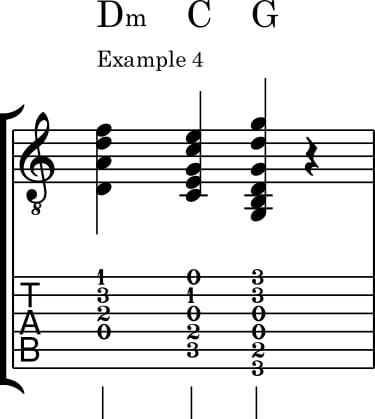
If you play it you might recognize the part of the song written by legendary George Harrison.
I – V – vi – IV
As you probably already guessed, every chord progression is a variation of something already existing. This one is no different. Here you will see an example of the chords used for the Beast Of Burden by the Rolling Stones.
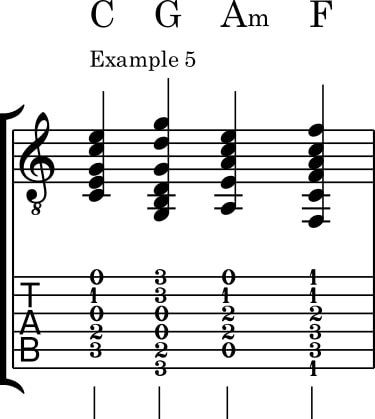
2 Other Rock Chord Progressions
Naturally, there are several other chord progressions used in rock music like ii – IV – V or VI – IV – I -V, but all of them will revolve around the same few chords. So feel free to experiment by yourself.
If you wish to learn more easy chord progression you can check out my other article 12 Simple & Easy Guitar Chord Progressions For Beginners
4 Sad Chord Progressions
Now, the main problem with sad progressions is that they won’t be played in the major keys.
While everything we mentioned so far is based on the major keys, there are so many songs that would sound really weird if we used the mentioned progressions.
Now if you wanted to create a sad song, your best option would be to use one of the minor modes. The most used and most common is natural minor or Aeolian. There are three minor scales natural, melodic, and harmonic.
Here is the chart for minor scales:
| Key | i | ii⁰ | III | iv | v | VI | VII |
| C minor | Cm | D⁰ | Eb | Fm | Gm | Ab | Bb |
| G minor | Gm | A⁰ | Bb | Cm | Dm | Eb | F |
| D minor | Dm | E⁰ | F | Gm | Am | Bb | C |
| A minor | Am | B⁰ | C | Dm | Em | F | G |
| E minor | Em | F#⁰ | G | Am | Bm | C | D |
| B minor | Bm | C#⁰ | D | Em | F#m | G | A |
| F# minor | F#m | G#⁰ | A | Bm | C#m | D | E |
| F minor | Fm | G⁰ | Ab | Bbm | Cm | Db | Eb |
| Bb minor | Bbm | C⁰ | Db | Ebm | Fm | Gb | Ab |
| Eb minor | Ebm | F⁰ | Gb | Abm | Bbm | Cb | Db |
| Ab minor | Abm | Bb⁰ | Cb | Dbm | Ebm | Fb | Gb |
| Db minor | Dbm | Eb⁰ | Fb | Gbm | Abm | Bbb | Cb |
| Gb minor | Gbm | Ab⁰ | Bbb | Cbm | Dbm | Ebb | Fb |
| Cb minor | Cbm | Db⁰ | Ebb | Fbm | Gbm | Abb | Bbb |
i – iv – v
This is one of the most popular and most common minor progressions. As you can see, we will use all minor chords for this progression.
While major chords generally sound triumphant and happy, minor ones will sound ominous and sad. Combining a few or more of them will create a beautifully sad piece that will give plenty of options for creating a song.
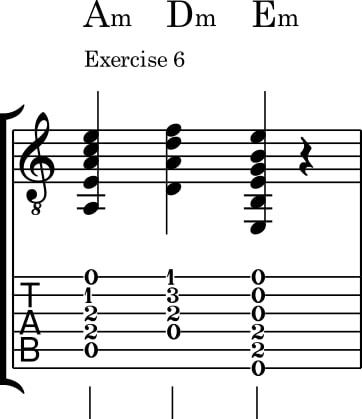
i – iv – V
If we take the previous progression i – iv – v and put major chord in the end and create i – iv – V progression with E major, in the end, the chord will still sound a lot sadder than we’re used to because of the root and the minor scale
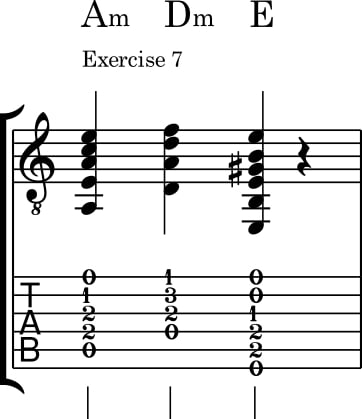
If you want to put those chord progressions to practice you can check out my list Top 45 Sad Guitar Songs That You Must Learn To Play
i – ii dim – V – i
In most minor chord progressions ii and V will usually be paired together. In the minor scale and minor chord progression, the second one is always diminished. So this progression will be in the key of A minor like this Am – B⁰ – E – Am
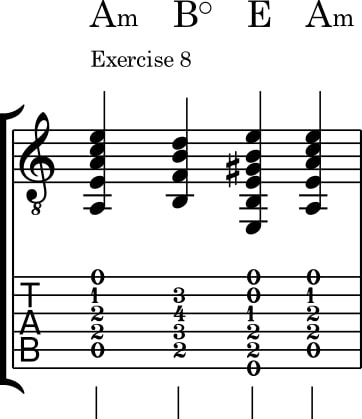
Furthermore, you can try this progression using any other key. For example, in Dm, the progression would be Dm – E⁰ – A – Dm, while in F minor would be Fm – G⁰ – C – Fm, and so on.
i – VI – III – VII
Not only that this progression has a majority of major chords, but it is one of the most popular progressions for ballads. Thanks to the root note and the minor scale, this progression will sound everything but happy.
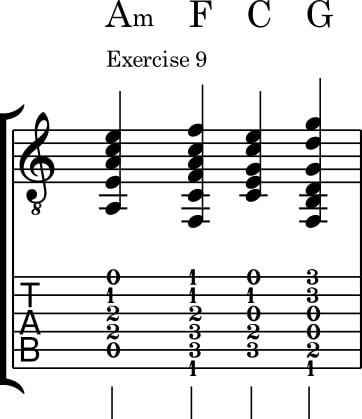
The progression used in A minor scale is Am – F – C – G, and in G minor, for example, the progression would go like this Gm – Eb – Bb – F.
4 Jazz Progressions
Now, when it comes to jazz, things get a bit more complicated.
Pop and rock music was created by people that never went to music school and was based on blues that had three chords. The whole point of rock and blues was in guitar solos and overdriven guitars.
However, when it comes to jazz, things get a bit more sophisticated.
Naturally, everything will get a bit more complex and difficult if you start practicing jazz. Furthermore, it might be a good idea to study music theory.
There are a few rules that we have to remember when it comes to jazz.
The first rule is that minor 7th chords are II chords. Secondly, V chords are dominant 7th, and finally, major 7th chords are I chords.
ii – V – I
Since ii – V – I is the most used jazz progression in the key of C would be Dm7 – G7 – Cmaj7. As you can see, things are already getting out of control, so it might be a good idea to study those not-so-common chords.
I – VI – II – V
We might have already mentioned this, but in the jazz version, this progression would be C – Am7 – Dm7 – G7. Not only that this is one of the most used progressions, but it is also one of the most important.
The progression originated in the I’ve Got Rhythm song by legendary George Gershwin and quickly became a landmark for the jazz musicians.
III – VI – II – V
The second progression is rather similar to the previous one with the first chord being the only difference.
I – II – V – IV
The progression also known as I to IV is common in both blues and jazz. Naturally, there will be a different type of chords here.
For an example of C major, the progression would look like this Cmaj7 – Gm7 – C7 – Fmaj7
Other Jazz Progressions
There are almost countless other jazz progressions you can create and use with these examples. Whether you decide to change the order of the chords or experiment with sevenths, or anything else, you will surely have fun.
However, each of the jazz progressions requires a bit more advanced guitar skill levels. So be careful if you are a beginner. It might get complicated really fast.
How To Compose Chord Progression By Yourself
While all the examples and combinations here sound like some arcane wisdom, the thing is rather simple.
There is no math or something hidden, but one great tool that you can use. The secret is in the Circle of Fifths.
This circle describes the connections and relationships between 12 notes of the chromatic scale along with their key signatures.
This circle of fifths originated in the 17th century and became one of the most important pieces of music theory.
By using this theory, you will be able to quickly shuffle through keys, modes, and chord progressions. There are tools that will allow you to select each of the modes and combine them with any possible key, and as a result, you will get all the chords you will be able to use.
Furthermore, each of them will be marked as major, minor, or diminished.
Naturally, it will require a bit of studying and a great deal of practice before you manage to quickly shuffle through all the notes and all the modes. But in time and with enough practice, it is something that you’ll be able to do.
The circle of fifths remains one of the most used and most important tools in creating music. In the table we used before, we mentioned keys and tones that are used for the major scale. Using the circle of fifths you can calculate any chord progression for any key.
For example, if you want Mixolydian mode in the key of F, the chords would be I, ii, iii⁰, IV, v, vi, VII. Where the I is F major, ii is G minor, iii⁰ is A diminished, IV is Bb major, v is C minor, vi is D minor, and VII is Eb major. And from there you could create any chord progression in Mixolydian mode.
Furthermore, you can apply this to anything you can imagine. However, it will require a great deal of practice and a bit of music theory.
Conclusion
There are so many chord progressions used in modern music only. But most of the things are “recycled” already. While we don’t mean this in a bad way, there are so many things to be done with the things that already exist.
If you love a particular song, try using the Roman numerals to write the chords and try to determine what the theory behind your favorite song is. See if that’s any of the progressions mentioned here.
If not, you can experiment using it in different keys. However, even if it’s one of the most commonly used progressions, it is good to know that there is something else that can be created with three simple chords.
You would be surprised to know how many songs use the same four chords and the same chord progression. Yet, almost every one of those songs sounds completely different.
Finally, the most important thing is practice. With enough practice and dedication, you will start noticing these patterns in popular songs, and in time you will realize how far through history all go.
You will also notice the connection between modern songs and songs that are a century old. While no one claims that this is easy, it can be conquered with enough practice and dedication.
So, keep playing and try to figure out the secrets of your favorite songs.
If you found this article useful, you may want to save this pin below to your Guitar board.
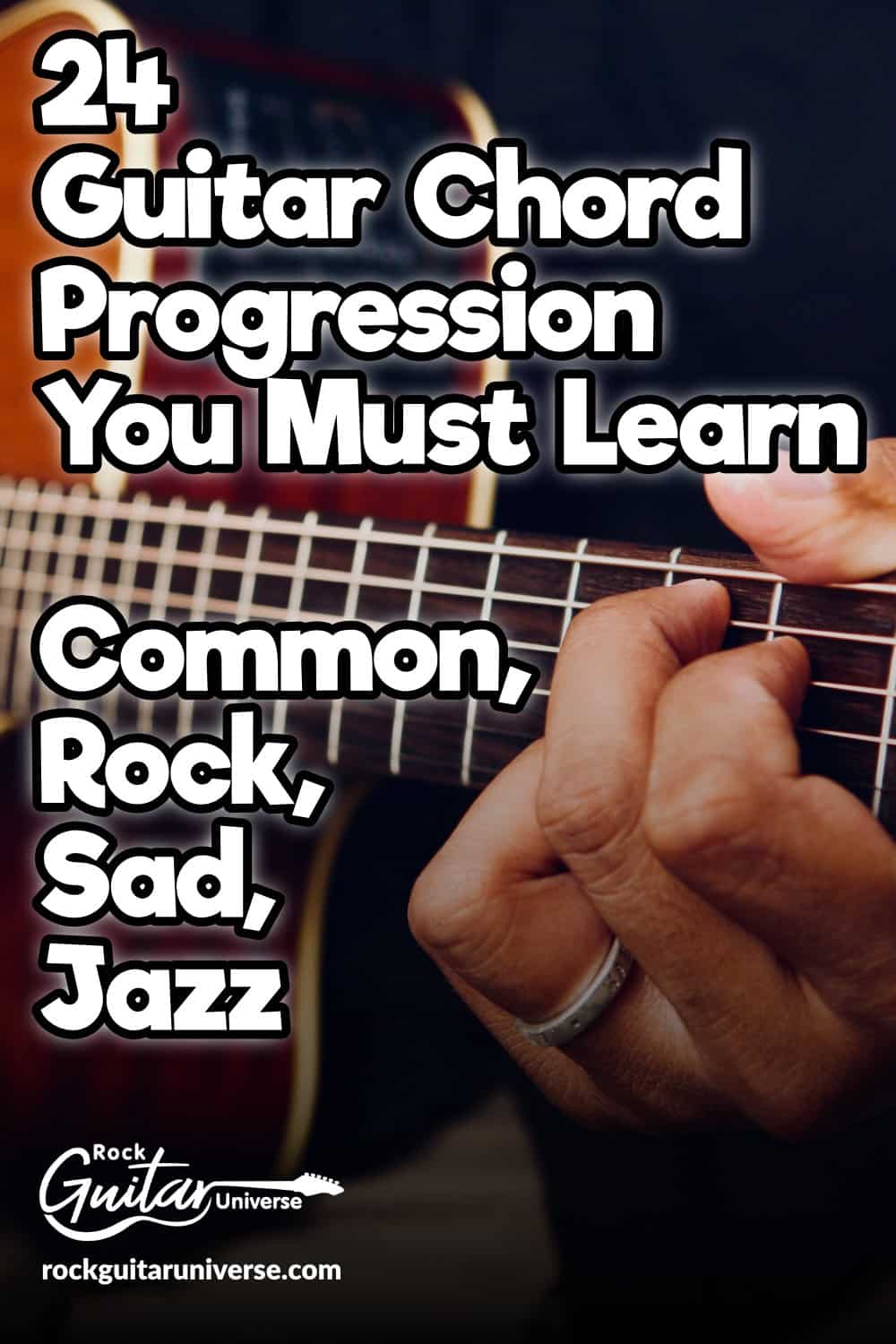
10 thoughts on “24 Guitar Chord Progression You Must Learn (Common, Rock, Sad, Jazz)”
Leave a Reply to Barry Chudakoff Cancel reply
Recent Posts
When learning new songs have you noticed that some of the chord sequences sound really good? But when you tried to come up with your own chord sequence, or as we call it chord progression, you found...
Some guitarists insist on buying an expensive amplifier with their electric guitar. They assume that this is a must for every type of guitarist out there. However, in some situations, this isn’t...

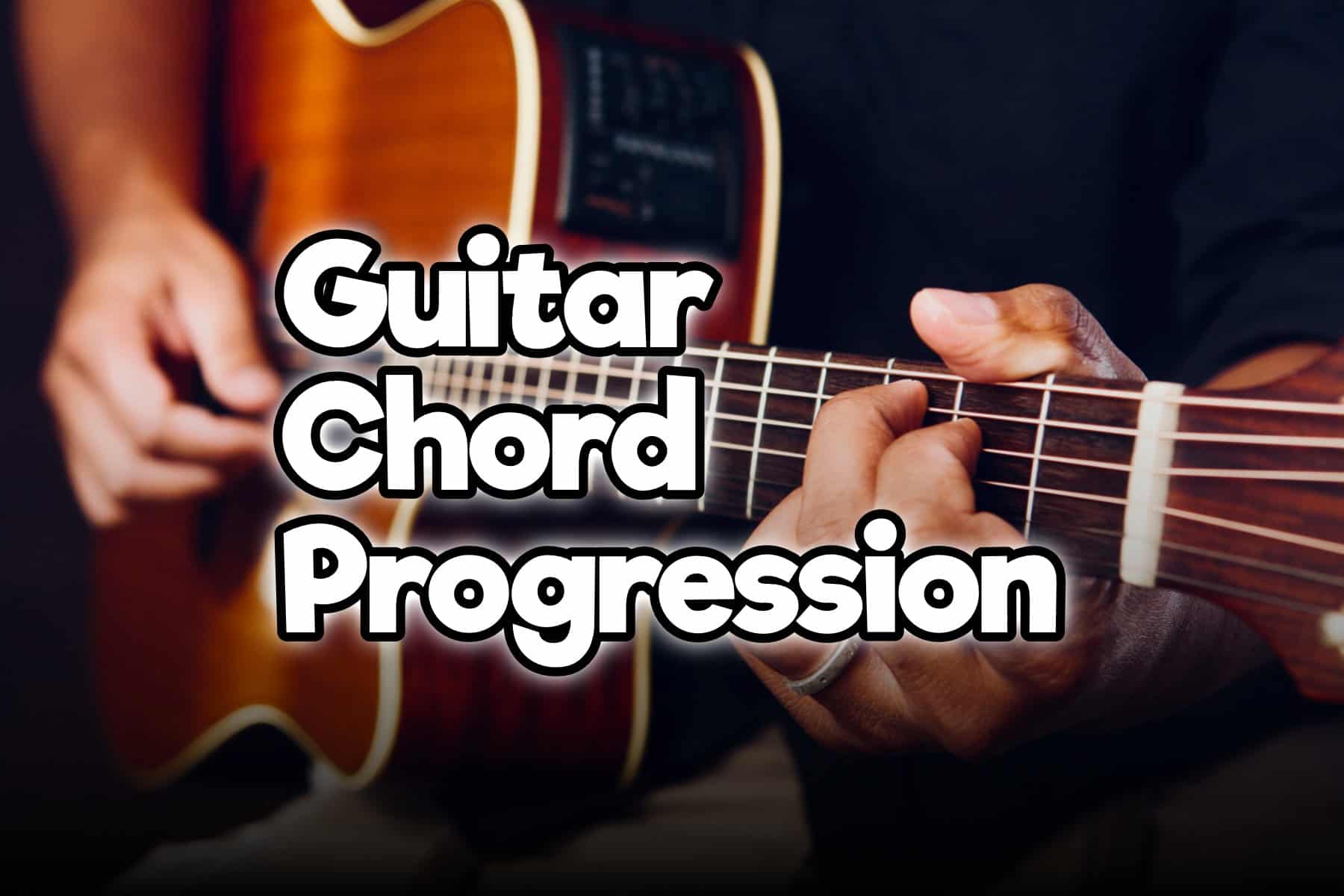
Hi, nice content!
It is helping me a log!
I think that may have a type in this exemple:
I – V – vi – iii – IV – I – IV – V
where the chord progression for Dmajor should be a F#m and not a Fm, this way:
D – A – Bm – F#m – G – D – G – A
Thanks!
I’m glad it’s helping you!
yes you are write there is a typo, I corrected it.
thanks for pointing this out.
Great lesson. Is there something that explains the circle of fifths relating it to modes. I would like to visualize how that works. Thanks,
Yes,
Check out my post Guitar Chord Families – In-Depth Guide With Charts
Well written and presented
Thanks!
I try to provide the best information I can.
Well done on the article and a lot of information, thanks,
you are welcome, hope it helped you 🙂
Very clear and well written, really. And it’s true, “modern” pop music relies on principles (and, sometime, styles) discovered and used more than three centuries ago (and then abandoned by the so-called “classic” music two centuries ago 🙂 lol)
Thank you was awesome help in understanding/simplying what chord progressions!
101 for noobs
Thanks again